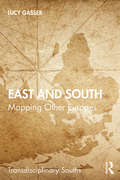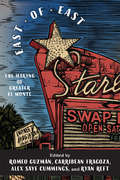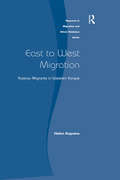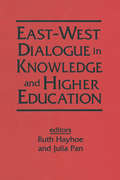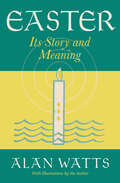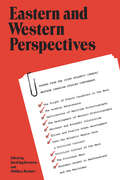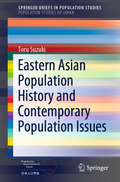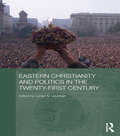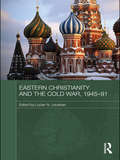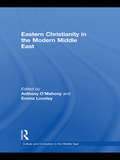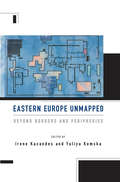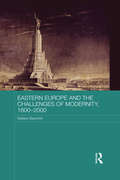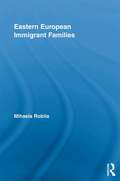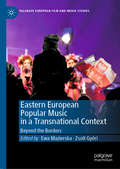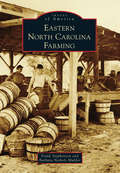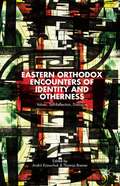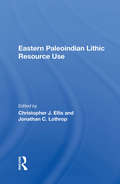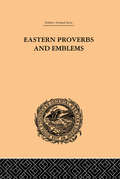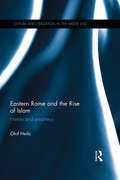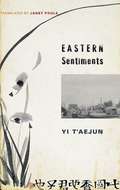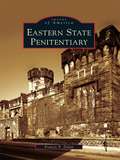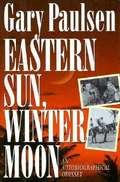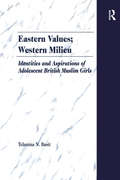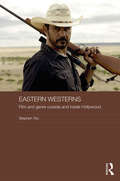- Table View
- List View
East and South: Mapping Other Europes
by Lucy GasserWhat is "Europe" in academic discourse?While Europe tends to be used as shorthand, often interchangeable with the "West", neither the "West" nor "Europe" are homogeneous spaces. Though postcolonial studies have long been debunking Eurocentrism in its multiple guises, there is still work to do in fully comprehending how its imaginations and discursive legacies conceive the figure of Europe, as not all who live on European soil are understood as equally "European".This volume explores this immediate need to rethink the axis of postcolonial cultural productions, to disarticulate Eurocentrism, to recognise Europe as a more diverse, plural and fluid space, to draw forward cultural exchanges and dialogues within the Global South. Through analyses of literary texts from East-Central Europe and beyond, this volume sheds light on alternative literary cartographies — the multiplicity of Europes and being European which exist both as they are viewed from the different geographies of the global South, and within the continent itself.Covering a wide spatial and temporal terrain in postcolonial and European cultural productions, this volume will be of great interest to scholars and researchers of literature and literary criticism, cultural studies, post-colonial studies, global South studies and European studies.
East of East: The Making of Greater El Monte (Latinidad: Transnational Cultures in the)
by Alex Espinoza Michael Jaime-Becerra Wendy Cheng David Reid Karen Wilson Michael Weller Mark Bray Carribean Fragoza Romeo Guzmán Alex Sayf Cummings Ryan Reft Aurelie Roy Maria John Daniel Lynch Daniel Cady Yesenia Barragan Melquiades Fernandez Rachel Newman Nick Juravich Juan Herrera Adam Goodman Daniel Morales Daniel Medina Andre Kobayashi Deckrow Jennifer Renteria Jude Webre Troy Andreas Kokinis Apolonio Morales Stacy I. Macías Toni Margarita Plummer Salvador PlascenciaEast of East: The Making of Greater El Monte, is an edited collection of thirty-one essays that trace the experience of a California community over three centuries, from eighteenth-century Spanish colonization to twenty-first century globalization. Employing traditional historical scholarship, oral history, creative nonfiction and original art, the book provides a radical new history of El Monte and South El Monte, showing how interdisciplinary and community-engaged scholarship can break new ground in public history. East of East tells stories that have been excluded from dominant historical narratives—stories that long survived only in the popular memory of residents, as well as narratives that have been almost completely buried and all but forgotten. Its cast of characters includes white vigilantes, Mexican anarchists, Japanese farmers, labor organizers, civil rights pioneers, and punk rockers, as well as the ordinary and unnamed youth who generated a vibrant local culture at dances and dive bars.
East to West Migration: Russian Migrants in Western Europe (Research in Migration and Ethnic Relations Series)
by Helen KopninaThe collapse of the communist regimes in Eastern Europe brought widespread fear of a 'tidal wave' of immigrants from the East into Western Europe. Quite apart from the social and political importance, East-West migration also poses a challenge to established theories of migration, as in most cases the migrant flow cannot be categorised as either refugee movement or a labour migration. Indeed much of the trans-border movement is not officially recognised, as many migrants are temporary, commuting, 'tourists' or illegal, and remain invisible to the authorities. This book focuses on Russian migration into Western Europe following the break-up of the Soviet Union. Helen Kopnina explores the concept of 'community' through an examination of the lives of Russian migrants in two major European cities, London and Amsterdam. In both cases Kopnina finds an 'invisible community', inadequately defined in existing literature. Arguing that Russian migrants are highly diverse, both socially and in terms of their views and adaptation strategies, Kopnina uncovers a community divided by mutual antagonisms, prompting many to reject the idea of belonging to a community at all. Based on extensive interviews, this fascinating and unique ethnographic account of the 'new migration' challenges the underlying assumptions of traditional migration studies and post-modern theories. It provides a powerful critique for the study of new migrant groups in Western Europe and the wider process of European identity formation.
East-West Dialogue in Knowledge and Higher Education
by Julia Pan Ruth HayhoeThis work is a dialogue on alternative approaches to knowledge and higher education characteristic of the Western University. Western scholars approach these issues from the viewpoint of the challenges facing the university and Eastern contributors explore parallel issues in their societies.
Easter: Its Story and Meaning
by Alan WattsTHE FORGOTTEN PAGAN ORIGINS OF CHRISTIANITY’S MOST EMBLEMATIC CELEBRATION “Easter — by whatever name it may be known — is a theme common to almost every religion and every people.” — Alan Watts Along with Christmas, Easter Sunday is one of the two most popular celebrations on the Church calendar. For millions of believers around the world, it encapsulates the central message of Christianity. Yet Easter has become associated with a perplexing jumble of non-Biblical customs: colorful eggs, chocolate rabbits, evening bonfires, children’s songs, mischievous games, and more. Philosopher Alan Watts proposes that these curiosities are vestiges of a tradition far older than Christianity. In Easter: Its Story and Meaning, Watts goes in search of the lost origins of Easter, taking readers with him on a kaleidoscopic tour of history, anthropology, and myth. He begins on the scorching plains of Bronze Age Mesopotamia, wanders the marble temples of imperial Rome, enters the glittering cathedrals of medieval Europe, and eventually lands in modern America. In the course of the journey, Watts unravels the multilayered symbolism of Easter and places the holiday within the broader context of world religions. He also delves into several tantalizing historical enigmas, such as: • Why is Christianity’s most sacred holiday named after a pagan goddess? • Is Jesus Christ historically unique, or is he just another example of the “dying-and-rising god” archetype common in antiquity? • How was the date of Easter calculated by the patriarchs of the early Church? • Where did the tradition of the Easter egg come from? (Could it be African?) The book closes on a lighthearted note, with a collection of weird and wonderful Easter folk traditions old and new. From beginning to end, Watts employs his keen intellect and vast erudition to uncover hidden connections between seemingly unrelated events. The result is a philosophical adventure that will enlighten readers of all religious backgrounds. Watts concludes that Easter is a universal celebration of nature’s eternal cycle of life, death, and rebirth — a celebration for all humanity.
Eastern & Western Perspectives: Papers from the Joint Atlantic Canada/Western Canadian Studs. Conference
by Phillip Buckner David Jay BercusonThe Atlantic Canada and Western Canada Studies Conferences have focused attention in recent years on the culture and development of two widely separated regions which have been frequently ignored in studies of the Canadian nation. The Atlantic Canada Studies Conference, meeting in 1974 and 1976 at the University of New Brunswick, and the Western Canadian Studies Conference, meeting annually since 1968 at the University of Calgary, have brought together scholars from a variety of disciplines to study the identities and characteristics of these two hinterlands. In 1978 the two conferences met jointly, in a session in Fredericton and one at Calgary with a core of speakers and papers common to both. The purpose was to compare and contrast subjects and experiences of interest and concern in the west and in Atlantic Canada. The ten papers which comprise Eastern and Western Perspectives are selected from twenty-seven presented at the joint conference.The topic chosen not only illustrate some of the preoccupations of regional historians and political scientists, but also echo many of the concerns of Canadians in general. The plight of islands and francophone culture in the midst of an overwhelmingly Anglo-American society, the search for identities in the face of persisting stereotypes, the effects of economic and urban development, the distinctiveness of local political cultures--all are subjects whose study enriches both regional and national history. This volume brings together explorations of these themes from eastern and western points of view and makes a unique contribution to a greater understanding and awareness of the regional dimension in Canadian life.
Eastern Asian Population History and Contemporary Population Issues (SpringerBriefs in Population Studies)
by Toru SuzukiThis book interprets and explains contemporary population issues from historical and cultural perspectives. These include lowest-low fertility in the Republic of Korea and Taiwan, early population aging in China relative to the developmental level, and various modes of domestic and international migration in the region. The book shows that divergent fertility decline can be attributed to the family patterns established in the pre-modern era in each country. It also examines the diversity of international migration in Eastern Asian countries today is also understood from the long-term historical view.
Eastern Christianity and Politics in the Twenty-First Century (Routledge Contemporary Russia and Eastern Europe Series)
by Lucian N. LeusteanThis book provides an up-to-date, comprehensive overview of Eastern Christian churches in Europe, the Middle East, America, Africa, Asia and Australia. Written by leading international scholars in the field, it examines both Orthodox and Oriental churches from the end of the Cold War up to the present day. The book offers a unique insight into the myriad church-state relations in Eastern Christianity and tackles contemporary concerns, opportunities and challenges, such as religious revival after the fall of communism; churches and democracy; relations between Orthodox, Catholic and Greek Catholic churches; religious education and monastic life; the size and structure of congregations; and the impact of migration, secularisation and globalisation on Eastern Christianity in the twenty-first century.
Eastern Christianity and the Cold War, 1945-91 (Routledge Studies in the History of Russia and Eastern Europe)
by Lucian N. LeusteanDespite widespread persecution, Orthodox churches not only survived the Cold War period but levels of religiosity in Orthodox countries remained significant. This book examines the often surprising relations between Orthodox churches and political regimes. It provides a comprehensive overview of the dynamics between Eastern Christianity and politics from the end of the Second World War to the fall of communism, covering 40 Orthodox churches including diasporic churches in Africa, Asia, America and Australia. Based on research from recently-opened archives and publications in a wide range of European languages, it analyses church-state relations on both sides of the Iron Curtain. It discusses the following key themes: the relationship between Orthodox churches and political power; religious resistance to communism; the political control of churches; religion and propaganda; monasticism and theological publications; religious diplomacy within the Orthodox commonwealth; and religious contacts between East and West.
Eastern Christianity in the Modern Middle East (Culture and Civilization in the Middle East)
by Emma Loosley Anthony O'MahonyThe Middle East is the birthplace of Christianity and the home to a number of Eastern Churches with millions of followers. This book provides a comprehensive survey of the various denominations in the modern Middle East and will be of interest to a wide variety of scholars and students studying theology, history and politics.
Eastern Europe Unmapped: Beyond Borders and Peripheries
by Yuliya Komska Irene KacandesArguably more than any other region, the area known as Eastern Europe has been defined by its location on the map. Yet its inhabitants, from statesmen to literati and from cultural-economic elites to the poorest emigrants, have consistently forged or fathomed links to distant lands, populations, and intellectual traditions. Through a series of inventive cultural and historical explorations, Eastern Europe Unmapped dispenses with scholars' long-time preoccupation with national and regional borders, instead raising provocative questions about the area's non-contiguous-and frequently global or extraterritorial-entanglements.
Eastern Europe and the Challenges of Modernity, 1800-2000 (BASEES/Routledge Series on Russian and East European Studies)
by Stefano BianchiniThis book presents a concise and comprehensive overview of the mainstream flows of ideas, politics and itineraries towards modernity in Central and Eastern Europe and the Balkans over two centuries from the beginning of the nineteenth century to the end of the Gorbachev administration. Unlike other books on the subject which view modernity based on the idea of Western European supremacy, this book outlines the various different pathways of development, and of growing industrialisation, urbanisation and secularisation which took place across the region. It provides rich insights on the complex networks whereby very varied ideas, aspirations and policies interacted to bring about a varied pattern of progress, and of integration and isolation, with different areas moving in different ways and at different paces. Overall the book presents something very different from the traditional picture of the" two Europes". Particular examples covered include agrarian reform movements, in various phases, different models of socialism, and different models of socialist reform.
Eastern European Immigrant Families (Routledge Advances in Sociology)
by Mihaela RobilaImmigration from Eastern Europe to the United States has grown significantly in the last few decades. While Asian and Latin American immigrations have been central to the discourse of migration to the US, the rapid growth of Eastern European immigrants has received insufficient attention. Robila fills this gap by presenting key issues related to immigration from Eastern Europe, such as child-rearing beliefs and practices, cultural beliefs, second-generational conflicts, as well as the challenges faced by Eastern European immigrants as they immigrate around the world.
Eastern European Popular Music in a Transnational Context: Beyond the Borders (Palgrave European Film and Media Studies)
by Ewa Mazierska Zsolt GyőriThis volume examines the transnational character of popular music since the Cold War era to the present. Bringing together the cross-disciplinary research of native scholars, Eastern European Popular Music in a Transnational Context expands our understanding of the movement of physical music, musicians and genres through the Iron Curtain and within the region of Eastern Europe. With case studies ranging from Goran Bregović, Czesław Niemen, the reception of Leonard Cohen in Poland, the Estonian punk scene to the Intervision Song Contest, the book discusses how the production and reception of popular music in the region has always been heavily influenced by international trends and how varied strategies allowed performers and fans to acquire cosmopolitan identities. Cross-disciplinary in nature, the investigations are informed by political, social and cultural history, reception studies, sociology and marketing and are largely based on archival research and interviews.
Eastern North Carolina Farming
by Frank Stephenson Barbara Nichols MulderSettled as a maritime and agricultural colony, North Carolina's history has always been intertwined with agriculture and farming. After the Civil War, North Carolina became the nation's top grower of tobacco, and one of the country's largest tobacco companies--the American Tobacco Company--flourished from the huge quantities of Eastern North Carolina-grown tobacco that was purchased. With the growing success of cotton farming and other crops and livestock--including corn, peanuts, and hogs--the region was particularly rich in subsistence farming. Over the course of the 20th century, farming and agriculture went through tremendous change. The familiar landscape of cotton and tobacco began to shift and include more varied crops, such as soybeans and sweet potatoes. At the same time, hand tools were exchanged for tractors and combines. Eastern North Carolina Farming showcases the rich history of this agriculturally dynamic region while telling the individual stories of farmers who grew for families, markets, and distribution.
Eastern Orthodox Encounters of Identity and Otherness
by Andrii Krawchuk Thomas BremerFrom diverse international and multi-disciplinary perspectives, the contributors to this volume analyze the experiences, challenges and responses of Orthodox Churches to the foundational transformations associated with the dissolution of the USSR.
Eastern Paleoindian Lithic Resource Use
by Christopher EllisOriginally published in 1989, Eastern Paleoindian Lithic Resource Use is a series of papers that examine Paleoindian lifeways from various viewpoints, all of which have their foundations in stone and examining artifacts. Exploring the link between lithic materials (especially cryptocrystallines and chert), and Paleoindian mobility and looking at the transport of stone, seasonal resource availability, stone caches, use as social markers and land movement patterns and its surrounding data.
Eastern Proverbs and Emblems: Illustrating Old Truths
by James LongFirst published in 2000. Routledge is an imprint of Taylor & Francis, an informa company.
Eastern Rome and the Rise of Islam: History and Prophecy (Culture and Civilization in the Middle East)
by Olof HeiloThe emergence of Islam in the seventh century AD still polarises scholars who seek to separate religious truth from the historical reality with which it is associated. However, history and prophecy are not solely defined by positive evidence or apocalyptic truth, but by human subjects, who consider them to convey distinct messages and in turn make these messages meaningful to others. These messages are mutually interdependent, and analysed together provide new insights into history. It is by way of this concept that Olof Heilo presents the decline of the Eastern Roman Empire as a key to understanding the rise of Islam; two historical processes often perceived as distinct from one another. Eastern Rome and the Rise of Islam highlights significant convergences between Early Islam and the Late Ancient world. It suggests that Islam's rise is a feature of a common process during which tensions between imperial ambitions and apocalyptic beliefs in Europe and the Middle East cut straight across today's theological and political definitions. The conquests of Islam, the emergence of the caliphate, and the transformation of the Roman and Christian world are approached from both prophetic anticipations in the Ancient and Late Ancient world, and from the Medieval and Modern receptions of history. In the shadow of their narratives it becomes possible to trace the outline of a shared history of Christianity and Islam. The "Dark Ages" thus emerge not merely as a tale of sound and fury, but as an era of openness, diversity and unexpected possibilities. Approaching the rise of Islam as a historical phenomenon, this book opens new perspectives in the study of early religion and philosophy, as well as providing a valuable resource for students and scholars of Islamic Studies.
Eastern Sentiments (Weatherhead Books on Asia)
by T'aejun YiThe Confucian gentleman scholars of the Choson dynasty (1392-1910) often published short anecdotes exemplifying their values and aesthetic concerns. In modern Seoul one scholar in particular would excel at adapting this style to a contemporary readership: Yi T'aejun.Yi T'aejun was a prolific and influential writer of colonial Korea and an acknowledged master of the short story and essay. He also wrote numerous novels and was an influential editor of cultural news. Born in northern Korea in 1904, Yi T'aejun settled in Seoul after a restless youth that included several years of study in Japan. In 1946, he moved to Soviet-occupied northern Korea, but by 1956, a purge of southern communists forced him into exile. His subsequent whereabouts cannot be confirmed, though rumors claim Yi returned to Pyongyang, only to be exiled once more. It is believed Yi T'aejun passed away between 1960 and 1980, but his works were not made available until 1988, when South Korean censorship laws concerning authors who had sided with the north were eased. The essays in this collection reflect Yi's distinct voice and lyrical expression, revealing thoughts on a variety of subjects, from gardens to immigrant villages in Manchuria, from antiques to colonial assimilation, and from fishing to the recovery of Korea's past. Yi laments the passing of tradition with keen sensibility yet, at the same time, celebrates human perseverance in the face of loss and change. Most important, his essays recount the author's attempt to re-experience the past and keep it alive against absorption into the Japanese nation. Janet Poole faithfully reproduces Yi's complex craft, retaining his idiosyncratic tone and narrative. A brilliant introduction to a remarkable prose stylist, Eastern Sentiments eloquently complicates the historical, political, and aesthetic concerns of Orientalism.
Eastern State Penitentiary (Images of America)
by Francis X. DolanThe most significant building project of its time, Eastern State Penitentiary was designed to reshape the mind of an inmate, rather than punish the body of one. It was believed that by keeping prisoners isolated in the chapel-like cells the inner light of their souls would emerge, leading them to discover penitence. In reality, the isolation was nearly impossible to maintain, and the lofty goals of thefounders crumbled in the 20th century, much like the building itself. Originally located on the outskirts of Philadelphia, the city eventually expanded and swallowed up the prison. Its unique location becameproblematic, and numerous escapes and riots threatened the civilian populace in the area. The prison was home to such well-known figures as Chicago mob boss Al Capone and bank robber Willie Sutton, once the most wanted man in America. Eastern State Penitentiary chronicles the history of this massive prison from its opening in 1829 to its closing and abandonment in 1971, and finally to the rebirth of the prison in the 1990s as a thriving historic site and national historic landmark.
Eastern Sun, Winter Moon: An Autobiographical Odyssey
by Gary PaulsenIn this memoir of a World War II childhood, Paulsen paints a haunting self-portrait of a young boy drawn helplessly into the physical and emotional violence of the adult world. "An indelible account...hallmarked by Paulsen's sinewy writing" (Kirkus Reviews).
Eastern Values; Western Milieu: Identities and Aspirations of Adolescent British Muslim Girls
by Tehmina N. BasitIn this book, Tehmina Basit examines the educational, social and career aspirations of adolescent Muslim girls in the context of their present experiences in contemporary Britain. She gathered data for the study over a period of twenty months, mainly by in-depth interviewing. The book portrays adolescence as a period of hope and expectation, rather than a time of stress, confusion and rebellion. The girls are optimistic about the future and, though largely working class, have middle class aspirations which they hope to realize through the mediums of education and careers. Nevertheless, they also want to get married and have children. While the girls’ aspirations are partly being shaped by the views of their parents and teachers, they are not replicating the lives of their parents and teachers. Indeed, they are active participants in shaping their own multiple identities and aspirations by means of a subtle combination of negotiation and persuasion.
Eastern Westerns: Film and Genre Outside and Inside Hollywood (Media, Culture and Social Change in Asia)
by Stephen TeoThe western, one of Hollywood’s great film genres, has, surprisingly, enjoyed a revival recently in Asia and in other parts of the world, whilst at the same time declining in America. Although the western is often seen as an example of American cultural dominance, this book challenges this view. It considers the western from an Asian perspective, exploring why the rise of Asian westerns has come about, and examining how its aesthetics, styles and politics have evolved as a result. It analyses specific Asian Westerns as well as Westerns made elsewhere, including in Australia, Europe, and Hollywood, to demonstrate how these employ Asian philosophical and mythical ideas and value systems. The book concludes that the western is a genre which is truly global, and not one that that is purely intrinsic to America.
